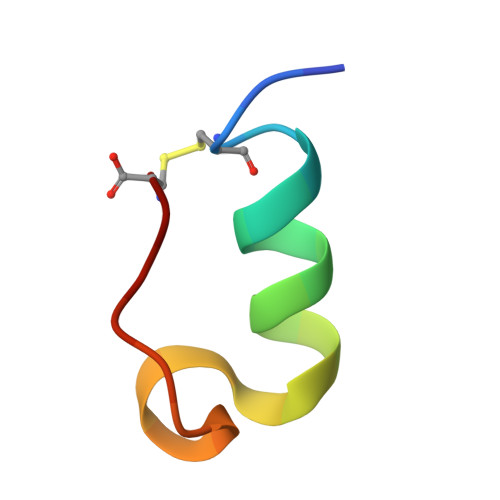Influence of Trp-Cage on the Function and Stability of GLP-1R Agonist Exenatide Derivatives.
Horvath, D., Straner, P., Taricska, N., Fazekas, Z., Menyhard, D.K., Perczel, A.(2024) J Med Chem
- PubMed: 39254428
- DOI: https://doi.org/10.1021/acs.jmedchem.4c01553
- Primary Citation of Related Structures:
9G0M, 9G0N, 9G20, 9G21, 9G22, 9G2N, 9G2O, 9G31, 9G32, 9G5P, 9GDL, 9GDN, 9GDT, 9GDU, 9GE1, 9GE9, 9GEB, 9GEC - PubMed Abstract:
Exenatide (Ex4), a GLP-1 incretin mimetic polypeptide, is an effective therapeutic agent against diabetes and obesity. We highlight the indirect role of Ex4's structure-stabilizing Trp-cage (Tc) motif in governing GLP-1 receptor (GLP-1R) signal transduction. We use various Ex4 derivatives to explore how Tc compactness influences thermal stability, aggregation, enhancement of insulin secretion, and GLP-1R binding. We found that Ex4 variants decorated with fortified Tc motifs exhibit increased resistance to unfolding and aggregation but show an inverse relationship between the bioactivity and stability. Molecular dynamics simulations coupled with a rigid-body segmentation protocol to analyze dynamic interconnectedness revealed that the constrained Tc motifs remain intact within the receptor-ligand complexes but interfere with one of the major stabilizing contacts and recognition loci on the extracellular side of GLP-1R, dislodging the N-terminal activating region of the hormone mimetics, and restrict the free movement of TM6, the main signal transduction device of GLP-1R.
Organizational Affiliation:
HUN-REN-ELTE Protein Modeling Research Group, ELTE Eötvös Loránd University, Pázmány Péter sétány 1/A, Budapest H-1117, Hungary.














